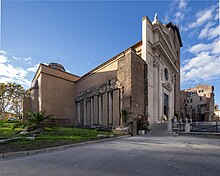San Nicola in Carcere
This article needs additional citations for verification. (February 2022) |
| San Nicola in Carcere | |
|---|---|
| Basilica of Saint Nicholas in Prison | |
Basilica di San Nicola in Carcere | |
Nicholas of Myra | |
| Architecture | |
| Architect(s) | Giacomo della Porta |
| Architectural type | medieval |
| Completed | 1599 |
| Administration | |
| Diocese | Rome |
San Nicola in Carcere (Italian, "
History
The first church on the site was probably built in the 6th century, and a 10th-century inscription may be seen on a fluted column next to the entrance, but the first definite dedication is from a plaque on the church dating to 1128. The inscriptions found in S. Angelo, a valuable source illustrating the history of the Basilica, have been collected and published by Vincenzo Forcella.[1]
It was constructed in and from the ruins of the Forum Holitorium and its Roman temples, along with a jail (carcer) which a tradition (supported by Pliny's history of Rome) states was sited in the temples' ruins.[citation needed] However, the in Carcere (in jail) part of the name of the church was only changed to "in Carcere Tulliano" in the 14th century, owing to an erroneous identification. The prison was really that of Byzantine times (LPD i.515, n13; ii.295, n12).

The dedication to St Nicholas was made by the Greek population in the area. In the 11th century, it was known as the church of Petrus Leonis, referring to the converted Jewish family, the Pierleoni, who rebuilt the nearby Theatre of Marcellus as a fortress. One of their members, Pietro Pierleone, was an important cardinal in the 1120s and was elected Pope Anacletus II, though he was later branded a schismatic antipope.[3]
The church was rebuilt in 1599, with a new facade by
Present

The church is known for celebrations to the devotion of the
Nearby structures include:
- Piazza Venezia
- Campidoglio
- Theatre of Marcellus
- Temple of Portunus in the Forum Boarium
- Santa Maria in Cosmedin and the Bocca della Verità
List of cardinal-deacons
- Ottaviano de Monticello (1138–1151)
- Ottone (1152–1174)
- Vibiano (1175)
- Gerardo (1175–1178)
- Bernardo (1178–1181)
- Pietro Diana (1185–1188)
- Egidio Pierleoni (1190–1194)
- Gerard OCist(1198–1199)
- Guido Pierleone (1205–1221)
- Otto of Tonengo (1227–1244)
- Giovanni Gaetano Orsini (1244–1277)
- Guglielmo Longhi (1294–1319)
- Giovanni Arlotti (1328), pseudocardinal
- Landolfo Maramaldo (1381–1415)
- Rodrigo Lanzol-Borja y Borja (1456–1484)
- Giovanni Battista Savelli (1484–1498)
- Amanieu d'Albret (1500–1520)
- Agostino Trivulzio, in commendam (1520–1531)
- Íñigo López de Mendoza y Zúñiga (1531–1537)
- Rodrigo Luis de Borja y de Castre Pinòs (1537)
- Girolamo Grimaldi, in commendam (1537–1538)
- Niccolò Caetani di Sermoneta(1538–1552)
- Giacomo Savelli (1552–1558)
- Giovanni Battista Consiglieri (1558–1559)
- Carlo Carafa (1560–1561)
- Francesco II Gonzaga (1561–1562)
- Georges d'Armagnac (1562–1585)
- Francesco Sforza (1585–1588)
- Ascanio Colonna (1588–1591)
- Federico Borromeo (1591–1593)
- Pietro Aldobrandini (1593–1604)
- Carlo Emmanuele Pio di Savoia(1604–1623)
- Carlo di Ferdinando de' Medici(1623–1644)
- Giangiacomo Teodoro Trivulzio(1644)
- Rinaldo d'Este (1644–1668)
- Friedrich von Hessen-Darmstadt (1668–1670)
- Paolo Savelli (1670–1678)
- Urbano Sacchetti (1681–1689)
- Gianfrancesco Ginetti (1689–1691)
- vacant (1691–1699)
- Henri Albert de La Grange d'Arquien (1699–1707)
- Lorenzo Altieri (1707–1718)
- Damian Hugo Philipp Reichsgraf von Schönborn-Buchheim (1721)
- vacant (1721–1728)
- Antonio Banchieri (1728–1733)
- vacant (1733–1738)
- Carlo Della Torre di Rezzonico (1738–1747)
- Mario Bolognetti (1747–1751)
- Domenico Orsini d'Aragona (1751–1763)
- vacant (1763–1770)
- Giovanni Battista Rezzonico (1770–1783)
- Romoaldo Braschi-Onesti (1787–1800)
- Marino Carafa di Belvedere (1801–1807)
- vacant (1807–1816)
- Pietro Vidoni (1816–1830)
- vacant (1830–1834)
- Nicola Grimaldi (1834–1845)
- Giuseppe Antonio Zacchia Rondinini (1845)
- Pietro Marini (1847–1863)
- vacant (1863–1874)
- Camillo Tarquini SJ (1874)
- Domenico Bartolini (1875–1876)
- Joseph Hergenröther (1879–1888)
- vacant (1888–1907)
- Gaetano De Lai (1907–1911)
- vacant (1911–1922)
- Giuseppe Mori (1922–1933) pro hac vice (1934)
- Nicola Canali (1935–1961)
- vacant (1961–1967)
- Patrick Aloysius O'Boylepro hac vice (1967–1987)
- SJ(1988)
- vacant (1988–1994)
- Alois GrillmeierSJ (1994–1998)
- Zenon Grocholewski (2001–2020)
- Silvano Maria Tomasi (2020-present)
References
- ^ V. Forcella, Inscrizioni delle chese e d' altre edifici di Roma, dal secolo XI fino al secolo XVI Volume IV (Roma: Fratelli Bencini, 1874), pp. 115-139.
- ^ Tacitus. Annales. II.49.
- ^ Mary Stroll, The Jewish Pope: Ideology and Politics in the Papal Schism of 1130 (New York: Brill Academic Pubs. 1987)., passim.
Bibliography
- Andreina Palombi, La basilica di San Nicola in Carcere: il complesso architettonico dei tre templi del Foro Olitorio (Roma: Istituto nazionale di studi romani, 2006).
- Franco Astolfi, I templi di San Nicola in Carcere (Roma : E.S.S. Editorial Service System, 1999). [Forma Urbis, 5. 1999, Supplemento].
- S. Nicola in Carcere (Roma : Istituto nazionale di studi romani, 1991). [no author]
- Giovanni Battista Proja, San Nicola in Carcere (Roma: Istituto di Studi Romani, 1981). [in Italian]
- Vincenzo Golzio, San Nicola in Carcere e i tre templi del Foro Olitorio (Roma: Libreria Fratelli Treves dell'Anonima Libraria Italiana, 1928). [in Italian]
External links
- Spherical panorama of the church interior Archived 2020-09-25 at the Wayback Machine
- Underground ruins
- High-resolution 360° Panoramas and Images of San Nicola in Carcere | Art Atlas
![]() Media related to San Nicola in Carcere at Wikimedia Commons
Media related to San Nicola in Carcere at Wikimedia Commons
| Preceded by Santi Nereo e Achilleo |
Landmarks of Rome San Nicola in Carcere |
Succeeded by San Pancrazio |
